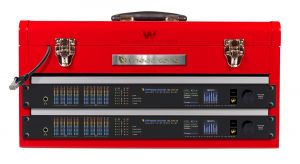 Switching between video feeds can be fairly straightforward. But switching audio feeds and creating an intercom between field reporters and the studio, not to mention setting mix-minuses – all of this can be cumbersome and time consuming. And that is where a new breed of digital mixing consoles with IP audio networking and integrated control can make all the difference.
Switching between video feeds can be fairly straightforward. But switching audio feeds and creating an intercom between field reporters and the studio, not to mention setting mix-minuses – all of this can be cumbersome and time consuming. And that is where a new breed of digital mixing consoles with IP audio networking and integrated control can make all the difference.
Creating and routing mix-minuses and other basic audio functions
Need to quickly send a mix-minus to a different telephone coupler because the existing one has smoke coming out of it? Or, perhaps your anchor in another location suddenly wants to join a live broadcast? Unexpected changes aren’t the tyranny of live production that they used to be because of what we’ve been able to put into WheatNet-IP, an IP audio network system with integrated control that includes an audio toolkit, plus control functions and intelligent routing at every IP node or connection point in the network.
Basic audio tools like processing and mix-minus creation are part of every WheatNet-IP BLADE, or the I/O access units located at connection points where audio sources and control surfaces connect to the IP network. These tools can be combined with routing and control functions so you can easily do things like send the appropriate mix-minus to a news anchor’s headset when he or she joins a live broadcast from a different location.
In much the same way, when a field reporter’s microphone goes live, the system can automatically send a mix-minus to the reporter’s earpiece. These are just a few of the ways combining logic with audio tools at each connection point in the network can make live production headache free.
Changing news sets and repurposing the newsroom
There’s much to be learned from the engineers who pioneered duopoly news operations, where combining the news production for two, three or more stations is impossibly difficult without IP audio networking and associated control. They got tired of having to re-route mic feeds, change IFBs, and reset all the different communication channels every time they changed stations. Now, by combining control and an audio toolkit at every connection point in the network, WheatNet-IP gives them access to not only all sources at once, but also the presets and any associated logic that goes along with each feed for controlling such things as mic ON/OFF, or changing remote mic settings for IFB, processing and other parameters.
Separately, control, audio tools and networking are each useful. But together, they make a powerful change agent that broadcasters are taking very seriously now that ATSC 3.0 is opening up new programming opportunities. Any newsroom that sits idle most of the day can now be turned into a multipurpose studio for other productions through the use of WheatNet-IP audio networking with integrated control.
Setting up an IP network intercom between reporters and studio ops
The uses for WheatNet-IP are virtually limitless. For example, any WheatNet-IP BLADE I/O unit that routes audio as an access point in the network also can provide the IFB path for communication on the other end of the IP audio network, whether it’s in another studio or on location. WheatNet-IP provides the pathway and the routable controls to let you set up a reverse IFB command for microphones. No more reaching for the intercom phone beneath the news desk, or spending an afternoon setting up IFB and mix-minus for field reporters.
The system also has configuration and reliability advantages. Because resources are built into each WheatNet-IP BLADE, network intelligence is distributed throughout the network. Every BLADE is a point of redundancy, as each one stores the entire configuration of the network. Adding on to your network is “plug and play;” networked BLADEs talk to each other and help introduce a new BLADE into their group. A major system expansion is simple because adding new BLADEs automatically adds more network intelligence, more control capability, and more audio processing and sub-mix resources.
Think about what all this means. Without you spending a penny extra on processing, or sub-mixing resources, or extra network control features, WheatNet-IP ships to your broadcast facility with everything you need to create hundreds of solutions to unique production activities. And now with the arrival of AES67, an audio IP transport standard Wheatstone helped bring to ratification in 2013, all your AES67 compatible peripheral gear can interface easily into WheatNet-IP.

